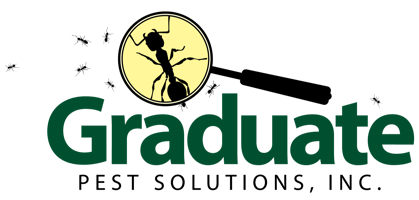One of the most common questions we get at Graduate is “how to tell the difference between a bee and a wasp?” There are some obvious differences and some are more subtle but knowing the difference between the two can be incredibly helpful. Whether you need to know for active pest control or preventative measures, being able to identify bees or wasps can be incredibly helpful. We’ll describe each so you can learn how to spot the differences. We’ll also cover some preventative techniques that can help you avoid the question in the first place.
Bees
Bees serve a critical role in the pollination of plants. They are also largely harmless. These things combined should give you comfort should you happen across one of these buzzing pests. Visually, bees are between ¼ to 1 inch in size, black and yellow markings, with an overall fuzzy appearance. Their nests are built out of pollen clumps, usually in the ground or dense clumps of grass. While they are considered beneficial because they pollinate flowers, they can sting if disturbed. If the nest is located on or near your home, then control is necessary.
Wasps
Unlike bees, which generally can only sting you once, wasps and hornets can sting you multiple times. There are multiple species native to our region and they are all quite territorial and will sting if they Identify you as a threat, especially near their nest!
- Bald-faced Hornets - about half an inch long, mostly black with a white pattern on the face. They build nests above ground, usually in exposed locations such as trees or overhangs. Of the types of wasps, these hornets can be somewhat beneficial because of their inherent ability to control other pests.
- European Hornets - larger, sometimes longer than an 1 inch. They are brown with yellow abdominal markings and a pale face. They build paper carton nests, usually with a brown “envelope” as protection. They are less likely to build their nest out in the open, preferring trees or walls with hollow interiors. Like bald-faced hornets, they do control our types of pests but will attack humans who get too close to their nests.
- Paper Wasps - between bald-faced hornets and European hornets when it comes to size, these wasps are somewhere in between with brown and yellow or reddish markings. They construct nests out of paper-like material. These nests sometimes look like an umbrella shape and hang from branches, railings, door frames or rafters. They are not particularly aggressive but will sting humans when disturbed.
- Yellow Jackets - the most notorious stinging insect is between ⅜ and ⅝ of an inch with a black and yellow striped color pattern. Their nests can grow to be the size of a basketball. Their nests can be found near the ground or in logs. They will also build them in shrubs, trees or hanging from houses. A particularly nasty surprise is when they make a nest in an abandoned chipmunk hole, and you ride over it with your mower!
Bee or wasp prevention
For both bees and wasps, the recommendations we have are similar. Start by eliminating potential nesting sites around the perimeter of the home, such as leaf piles, debris piles (deleted mulch), and overgrown vegetation. Also, consider eliminating potential attractants like standing pools of water. Untended kiddie pools, flowerpots, and old tires will hold water that attracts foraging bees and wasps. You should seal possible points of entry into the home with a quality silicone caulk. Pay special attention to cracks in the foundation, utility pipes, and windows. If one portion of your home spends much of the day in the sun, focus on that area. Repair window screens if they’re torn or fit poorly.
Download Our Guide to Stinging Insects
Need to get some pests to buzz off? Call us at 413-566-8222 or contact us with any questions or if you are experiencing a pest problem. We have the knowledge and the services necessary to help keep your home pest-free!
YOU MAY ALSO LIKE
These related articles

